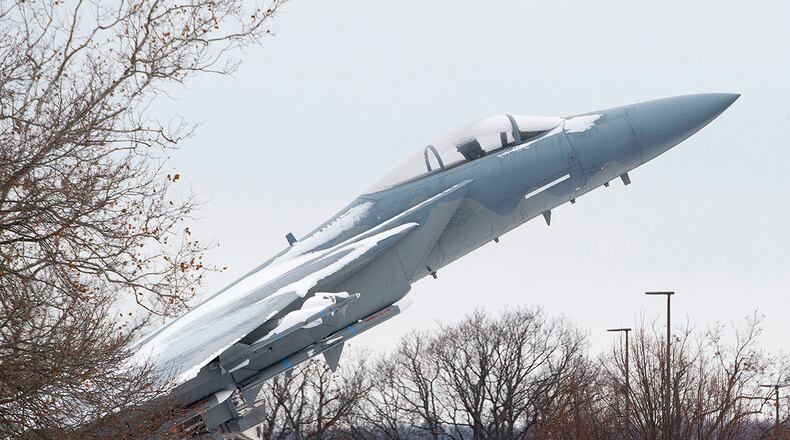“We realize that our efforts for this are more of a marathon than a sprint,” said Keith Tickle, who was named AFMC’s diversity, equity and inclusion officer in the spring of 2020.
“There really is not one silver bullet or quick fix,” said Bill Snodgrass, AFMC’s manpower, personnel and services director.
This survey is the first time to Snodgrass’ knowledge that AFMC has conducted a commandwide survey exploring diversity and inclusion.
AFMC is an important Air Force command, responsible for the Air Force’s massive material, logistics and research needs and missions. The command, which is headquartered at Wright-Patterson Air Force Base, has about 40% of all Air Force civilian employees — nearly 71,000 civilian employees, with an additional 19,113 uniformed employees.
Among the survey’s findings: Of all responding civilian employees, 20% stated that they believed hiring is impacted by race and/or ethnicity.
While some respondents believed promotion and hiring actions are biased against Black people and women, others said opportunities are limited based on a perceived “reverse racism” that favors minorities.
More findings: Although 73% of survey respondents indicate that AFMC organizations encourage the use of a command equal opportunity program to report and address complaints of discrimination, only 69% believe they can use the program without fear of reprisal. In other words, more than 30% of respondents indicated they did not believe they could turn to the program without fear of reprisal — a number that is too high for AFMC leaders.
“We did find that concerning but not completely surprising,” Snodgrass said. As a result, command leaders are working to “grab small problems before they become big ones,” he said.
“When you look at it on the surface, you say, ‘Man, that kind of stands out,’” Tickle said of that finding. “But I will tell you that everything we pulled from the survey was very important to us.”
He emphasized that no employee should fear turning to the command’s equal opportunity office or calling attention to problems.
“We want those fears to be mitigated,” Tickle said.
Among the responses that stood out to AFMC officials: Many in the lower ranks were not aware of command efforts in this area, Tickle said.
“Some of those need to be communicated rather rapidly because we understand this is a totality effort of the entire AFMC enterprise,” he said. “We’ve got to make sure we have buy-in and understanding at the lowest levels.”
Some comments in response to the survey also showed what the command called a “misperception” that “hiring quotas” based on race and ethnicity control hiring decisions.
But Tickle noted that by law, there can be no hiring quotas. “We’re hiring on merit.”
“Our efforts are driven toward maximizing equality of opportunity,” Tickle said. “We’re going to mitigate any inequity that are barriers to equality of opportunity.”
“The survey shows that while we are opening minds to many blind spots that would have previously gone unnoticed, we still have a lot of work to do, as we continue our efforts to become a more diverse and inclusive AFMC,” Gen. Arnold W. Bunch Jr., AFMC commander, said in a command statement on the survey results.
Added Bunch: “It is imperative that we get this right. We need to have an environment where every airman feels accepted, valued and has the opportunity to achieve their full potential. These results will help guide our continued efforts.”
Command leaders need to consider grievance data, exit interviews with employees, anecdotal evidence, focus group findings and more, Tickle and Snodgrass said.
But there is far more to do than consider data, they also said. Snodgrass said leaders need to resist the temptation to “roll out some annual training” and consider the job done.
“Gen. Bunch has told us: Now is the time to be bold,” Snodgrass said. “We need to step out and kind of get after this.”
AFMC officials will brief senior personnel leaders of the Air Force on the survey’s findings soon, perhaps as early as next week.
Tickle said there are plans to make this survey an annual event.
The Air Force Office of Diversity and Inclusion was established in December of 2020, and similar offices are now being stood up across the Air Force major commands.
While AFMC has its headquarters at Wright-Patterson, it also has a major presence at the Air Force Test Center at Edwards Air Force Base in California the Air Force Sustainment Center at Tinker AFB in Oklahoma, the Air Force Installation and Mission Support Center at Joint Base San Antonio, and the Air Force Nuclear Weapons Center at Kirtland AFB in New Mexico.
Air Force Materiel Command demographics, total command workforce, military and civilian.
70,902 civilians and 19,113 military
White male: 56.5%
White female: 18.09%
Black male: 7.78%
Black female: 4.66%
Asian male: 2.8%
Asian female: 1.2%
Hispanic (both sexes): 8.09%
Hawaiian native other Pacific islander male: 0.37%
Hawaiian native /other Pacific islander female: 0.16%
Multiracial male: 2.28%
Multiracial female: 1.03%
Not identified/declined to respond: Male: 2.7%; female: 1.02%
Source: AFMC
About the Author



